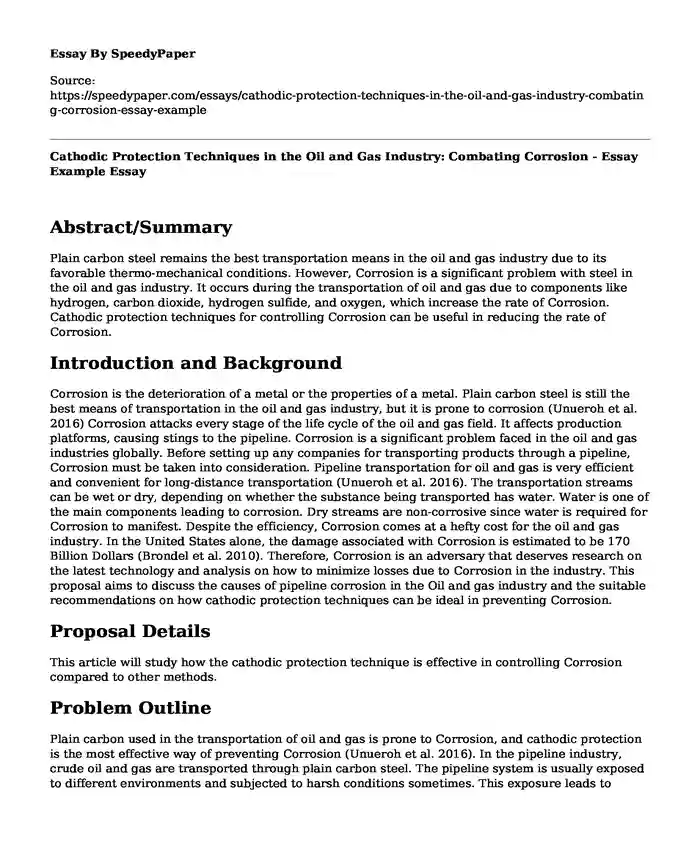
| Type of paper: | Essay |
| Categories: | Company Case study |
| Pages: | 3 |
| Wordcount: | 683 words |
Abstract/Summary
Plain carbon steel remains the best transportation means in the oil and gas industry due to its favorable thermo-mechanical conditions. However, Corrosion is a significant problem with steel in the oil and gas industry. It occurs during the transportation of oil and gas due to components like hydrogen, carbon dioxide, hydrogen sulfide, and oxygen, which increase the rate of Corrosion. Cathodic protection techniques for controlling Corrosion can be useful in reducing the rate of Corrosion.
Introduction and Background
Corrosion is the deterioration of a metal or the properties of a metal. Plain carbon steel is still the best means of transportation in the oil and gas industry, but it is prone to corrosion (Unueroh et al. 2016) Corrosion attacks every stage of the life cycle of the oil and gas field. It affects production platforms, causing stings to the pipeline. Corrosion is a significant problem faced in the oil and gas industries globally. Before setting up any companies for transporting products through a pipeline, Corrosion must be taken into consideration. Pipeline transportation for oil and gas is very efficient and convenient for long-distance transportation (Unueroh et al. 2016). The transportation streams can be wet or dry, depending on whether the substance being transported has water. Water is one of the main components leading to corrosion. Dry streams are non-corrosive since water is required for Corrosion to manifest. Despite the efficiency, Corrosion comes at a hefty cost for the oil and gas industry. In the United States alone, the damage associated with Corrosion is estimated to be 170 Billion Dollars (Brondel et al. 2010). Therefore, Corrosion is an adversary that deserves research on the latest technology and analysis on how to minimize losses due to Corrosion in the industry. This proposal aims to discuss the causes of pipeline corrosion in the Oil and gas industry and the suitable recommendations on how cathodic protection techniques can be ideal in preventing Corrosion.
Proposal Details
This article will study how the cathodic protection technique is effective in controlling Corrosion compared to other methods.
Problem Outline
Plain carbon used in the transportation of oil and gas is prone to Corrosion, and cathodic protection is the most effective way of preventing Corrosion (Unueroh et al. 2016). In the pipeline industry, crude oil and gas are transported through plain carbon steel. The pipeline system is usually exposed to different environments and subjected to harsh conditions sometimes. This exposure leads to internal and external Corrosion. Due to the natural composition of crude oil and gas, Corrosion is inevitable, hence the need to find solutions in minimizing and reducing Corrosion (Brondel et al. 2010). Many methods of preventing Corrosion exist, but cathodic protection is the most efficient method (Unueroh et al. 2016).
Proposed plan
To study the effectiveness of the cathodic protection method vis a vis other protection methods and record the results. The study will be done for a year, and the results will be recorded quarterly. The results will be translated to show which method is more effective in protecting Corrosion.
Feasibility
The study will be carried out on one major pipeline company using corrosion prevention techniques. The pipeline system will be divided into kilometers, depending on different corrosion prevention methods. The progress will be recorded monthly, and the whole report will be analyzed after the end of the year.
Outcomes and Recommendations
An effective corrosion control method should identify the relevant corrosion damage techniques and contain mitigation techniques and monitoring (Unueroh et al. 2016). It is also imperative that corrosion mechanisms be adequately researched and understood to develop better corrosion control techniques. To sum up, aging infrastructure, cost and safety, and increased performance requirements drive a more comprehensive corrosion control. Experiments in extreme environments can always be informative in the section on design and material selection.
References
Brondel, D., Edwards, R., Hayman, A., Hill, D., Mehta, S., & Semerad, T. (2010). Corrosion in the oil industry. Oilfield Review, 6(2), 4-18.
Unueroh, U., Omonria, G., Efosa, O., & Awotunde, M. (2016). Pipeline corrosion control in oil and gas industry: a case study of NNPC/PPMC system 2A pipeline. Nigerian Journal of Technology, 35(2), 317-320.
Cite this page
Cathodic Protection Techniques in the Oil and Gas Industry: Combating Corrosion - Essay Example. (2023, Nov 06). Retrieved from https://speedypaper.net/essays/cathodic-protection-techniques-in-the-oil-and-gas-industry-combating-corrosion-essay-example
Request Removal
If you are the original author of this essay and no longer wish to have it published on the SpeedyPaper website, please click below to request its removal:
- Essay Sample on the Potential to Write at Your Best
- Essay Example on Behavioral Intervention Strategies for ASD Patients
- Free Essay with the UVA Transfer Application Letter
- Paper Example on Comparison of Two Cases of Fraud in Companies
- Free Essay in Finance: Amazon Financial Performance and Health
- Essay Example: What Steps Would You Follow to Assess an Emerging Disaster Situation?
- Levy Case Study - Free Essay Example
Popular categories




